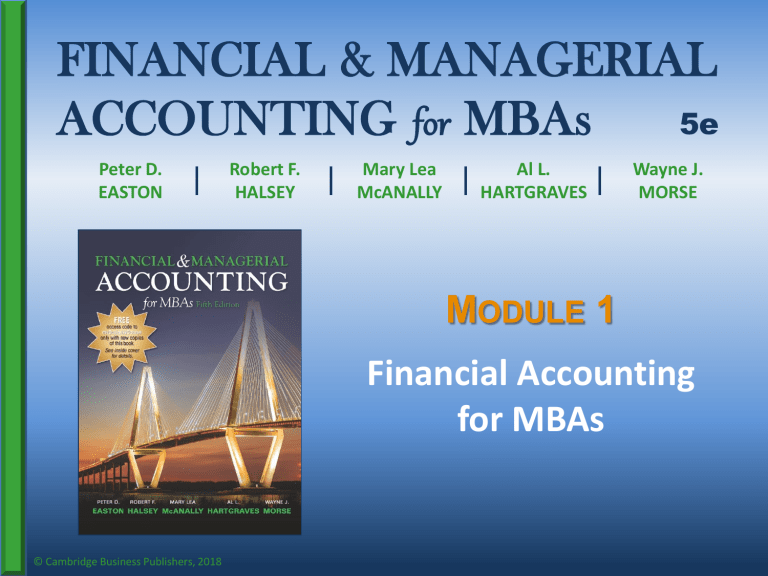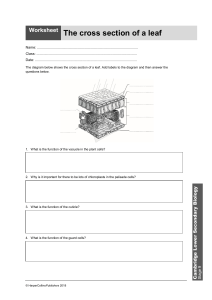
FINANCIAL & MANAGERIAL ACCOUNTING for MBAs 5e Peter D. EASTON Robert F. HALSEY Mary Lea McANALLY Al L. HARTGRAVES Wayne J. MORSE MODULE 1 Financial Accounting for MBAs © Cambridge Business Publishers, 2018 Learning Objective 1 Explain and assess the four main business activities. © Cambridge Business Publishers, 2018 2 Four Types of Activities Companies Plan business activities, Finance those activities, Invest in those activities, Then engage in operating activities © Cambridge Business Publishers, 2018 3 Business Activities and Financial Statements © Cambridge Business Publishers, 2018 4 Learning Objective 2 Identify and discuss the users and suppliers of financial statement information. © Cambridge Business Publishers, 2018 5 Demand for Financial Accounting Information Managers and employees: current and future financial health. Investment analysts and information intermediaries: predicting companies’ future performance. Creditors and suppliers: to help determine loan terms, loan amounts, interest rates, and required collateral. Stockholders and directors: to assess the profitability and risks of companies and other information useful in their investment decisions Customers and strategic partners: to assess a company’s ability to provide products or services and to assess the company’s staying power and reliability. Regulators and tax agencies: for antitrust assessments, public protection, setting prices, import-export analyses, and setting tax policies. Voters and their representatives: economic, social, taxation, and other initiatives, and to monitor government spending. © Cambridge Business Publishers, 2018 6 Supply of Financial Accounting Information The quantity and quality of accounting information that companies supply are determined by managers’ assessment of the benefits and costs of disclosure. Form 10-K: the audited annual report that includes the four financial statements with explanatory notes and the management’s discussion and analysis (MD&A) of financial results. Form 10-Q: the unaudited quarterly report that includes summary versions of the four financial statements and limited additional disclosures. © Cambridge Business Publishers, 2018 7 Benefits of Disclosure The benefits of supplying accounting information extend to a company’s capital, labor, input, and output markets. Cost of capital (as reflected in lower interest rates or higher stock prices), Recruiting efforts in labor markets, and the ability to establish superior Supplier-customer relations in the input and output markets © Cambridge Business Publishers, 2018 8 Costs of Disclosure Preparation and dissemination of financial information, Competitive disadvantages, Litigation potential, and Political costs. © Cambridge Business Publishers, 2018 9 SEC’s Regulation Fair Disclosure (FD) Goal is to curb the practice of selective disclosure by public companies. Reg FD reads as follows: “Whenever an issuer discloses any material nonpublic information regarding that issuer, the issuer shall make public disclosure of that information . . . simultaneously, in the case of an intentional disclosure; and . . . promptly, in the case of a non-intentional disclosure.” © Cambridge Business Publishers, 2018 10 International Accounting Standards Companies in more than 120 countries, including the European Union, the United Kingdom, Canada, and Japan use International Financial Reporting Standards (IFRS) for their financial reports. International Accounting Standards Board (IASB) oversees the development of IFRS. The IASB and the Financial Accounting Standards Board (FASB) work together cooperatively, often undertaking joint projects. Consequently, IFRS and U.S. GAAP (generally accepted accounting principles) are generally more alike than different for most transactions. © Cambridge Business Publishers, 2018 11 Learning Objective 3 Describe and examine the four financial statements, and define the accounting equation. © Cambridge Business Publishers, 2018 12 Financial Statement Links Across Time © Cambridge Business Publishers, 2018 13 Balance Sheet Reports a company’s financial position at a point in time. Resources (assets), namely what the company owns Sources of asset financing From stockholders—owner financing, or From banks or other creditiors and suppliers—nonowner financing Accounting equation The accounting equation works for all companies at all points in time. © Cambridge Business Publishers, 2018 14 Under Armour Balance Sheet © Cambridge Business Publishers, 2018 15 Investing Activities Represented by the company’s assets. Assets are listed on the balance sheet in order of their nearness to cash. The relative proportion of short- and long-term assets is largely determined by a company’s industry and business model. © Cambridge Business Publishers, 2018 16 Financing Activities Companies use a combination of owner (or equity) and nonowner financing (liabilities or debt). Owner financing has two components: Resources contributed to the company by its owners, and Profits retained by the company. © Cambridge Business Publishers, 2018 17 Income Statement Reports on a company’s performance over a period of time and lists amounts for Its top line revenues (also called sales) and Its expenses. Revenues less expenses equals the bottom-line net income amount (also called profit or earnings). © Cambridge Business Publishers, 2018 18 Income Statement © Cambridge Business Publishers, 2018 19 Expenses Cost of goods sold (COGS, also called cost of sales)— the amount Under Armour paid to purchase or manufacture the goods (inventories) that it sold. Gross profit = Revenues – Cost of goods sold Selling, general, and administrative expenses (SG&A) —the overhead of the company, including Salaries Marketing costs Occupancy costs HR and IT costs All the other operating expenses the company incurs. © Cambridge Business Publishers, 2018 20 Net Income The ability of companies to create barriers to competitive pressure, either by patent protection, effective marketing, etc. is a key factor in determining their level of profitability. © Cambridge Business Publishers, 2018 21 Statement of Stockholders’ Equity Reports on year-over-year changes in the equity accounts that are reported on the balance sheet: Contributed capital, the stockholders’ net contributions to the company, Retained earnings, net income over the life of the company minus all dividends ever paid. Other equity, consists of amounts we explain later in the book. © Cambridge Business Publishers, 2018 22 Statement of Stockholders’ Equity © Cambridge Business Publishers, 2018 23 Statement of Cash Flows Reports cash inflows and outflows from operating, investing, and financing activities over a period of time. © Cambridge Business Publishers, 2018 24 Information Beyond Financial Statements Management Discussion and Analysis (MD&A) Independent auditor report Financial statement footnotes Regulatory filings, including proxy statements and other SEC filings © Cambridge Business Publishers, 2018 25 Managerial Choices in Financial Accounting GAAP allows companies choices in preparing financial statements. The choice of methods can yield financial statements that are markedly different from one another in terms of reported income, assets, liabilities, and equity amounts. Financial statements also comprise numerous estimates. © Cambridge Business Publishers, 2018 26 Sarbanes-Oxley Act (SOX) The statements signed by both the CEO and CFO contain the following declarations: Both the CEO and CFO have personally reviewed the annual report. There are no untrue statements of a material fact that would make the statements misleading. Financial statements fairly present in all material respects the financial condition of the company. All material facts are disclosed to the company’s auditors and board of directors. No changes to its system of internal controls are made unless properly communicated. © Cambridge Business Publishers, 2018 27 Learning Objective 4 Explain and apply basic profitability analysis. © Cambridge Business Publishers, 2018 28 Return on Assets © Cambridge Business Publishers, 2018 29 Profitability and Productivity Across Companies © Cambridge Business Publishers, 2018 30 Relation Between Earnings and Stock Prices Ball, R., and P. Brown. 1968. “An empirical evaluation of accounting income numbers.” Journal of Accounting Research (Autumn): 159–178. © Cambridge Business Publishers, 2018 31 Relation between Financial Ratios and Credit Ratings © Cambridge Business Publishers, 2018 32 Learning Objective 5 Assess business operations within the context of a competitive environment. © Cambridge Business Publishers, 2018 33 Analyzing the Competitive Environment © Cambridge Business Publishers, 2018 34 Competitive Forces within the Broader Business Environment Industry competition. Competition and rivalry raise the cost of doing business. Bargaining power of buyers. Buyers with strong bargaining power can extract price concessions. Bargaining power of suppliers. Suppliers with strong bargaining power can demand higher prices. Threat of substitution. As the number of product substitutes increases, sellers have less power to raise prices and/or pass on costs to buyers. Threat of entry. New market entrants increase competition and companies must expend monies on activities such as new technologies, promotion, and human development to erect barriers to entry and to create economies of scale. © Cambridge Business Publishers, 2018 35 SWOT Analysis of the Business Environment SWOT - strengths, weaknesses, opportunities and threats. Internal - strengths and weaknesses External - opportunities of and threats © Cambridge Business Publishers, 2018 36 Analyzing Competitive Advantage Does the company have a competitive advantage, and, if so, what factors explain it? Is the competitive advantage sustainable? If the company has no competitive advantage, does its management have a plan to develop a sustainable competitive advantage that can be implemented in an acceptable period of time and with a reasonable amount of investment? © Cambridge Business Publishers, 2018 37 Achieving Competitive Advantage Product differentiation Technological innovation Product design Marketing, distribution, and after-sale customer support Cost leader Access to low-cost raw materials or labor Manufacturing or service efficiency, and Manufacturing scale efficiencies, greater bargaining power with suppliers, sophisticated IT systems, etc. © Cambridge Business Publishers, 2018 38 Learning Objective 6 Appendix 1A Access reports filed with the SEC. © Cambridge Business Publishers, 2018 39 SEC’s EDGAR - 1 © Cambridge Business Publishers, 2018 40 SEC’s EDGAR - 2 © Cambridge Business Publishers, 2018 41 SEC’s EDGAR - 3 © Cambridge Business Publishers, 2018 42 Learning Objective 7 Appendix 1B Describe the accounting principles and regulations that frame financial statements. © Cambridge Business Publishers, 2018 43 Financial Accounting Environment Securities and Exchange Commission (SEC) Broad powers to regulate the issuance and trading of securities. Companies with more than $10 million in assets and whose securities are held by more than 500 owners Must file annual and other periodic reports, including financial statements that are available for download from the SEC’s database Financial Accounting Standards Board (FASB) Sets U.S. financial accounting standards called Generally Accepted Accounting Principles (GAAP) © Cambridge Business Publishers, 2018 44 Audits and Corporate Governance © Cambridge Business Publishers, 2018 45 Audit Report Financial statements for each publicly traded company must be audited by an independent audit firm. A company’s board of directors hires the auditors to review and express an opinion on its financial statements. The basic “clean” audit report is consistent across companies and includes these assertions: Financial statements are management’s responsibility. Auditor responsibility is to express an opinion on those statements. Auditing involves a sampling of transactions, not investigation of each transaction. Audit opinion provides reasonable assurance the statements are free of material misstatements, not a guarantee. Auditors review accounting policies used by management and the estimates used in preparing the statements. Financial statements present fairly, in all material respects a company’s financial condition, in conformity with GAAP. © Cambridge Business Publishers, 2018 46 Audit Committee Corporate Governance Structure © Cambridge Business Publishers, 2018 47 The End 48




